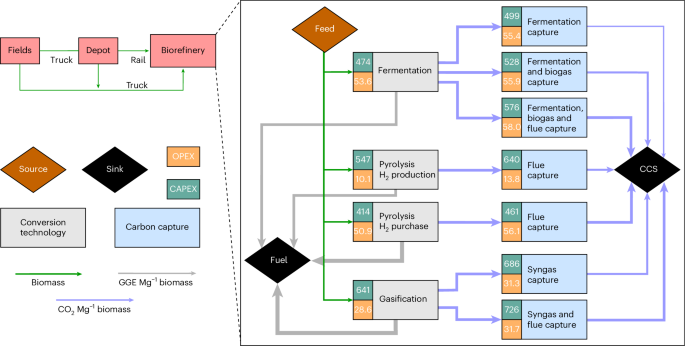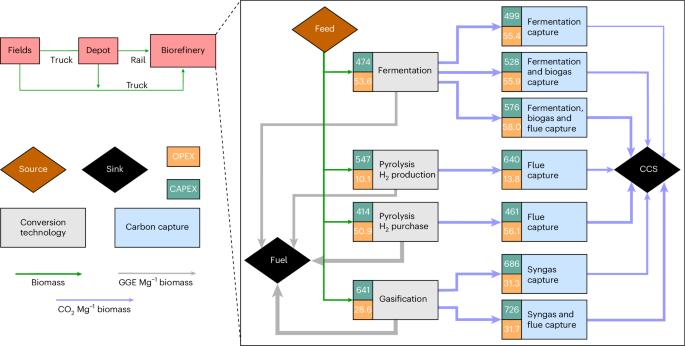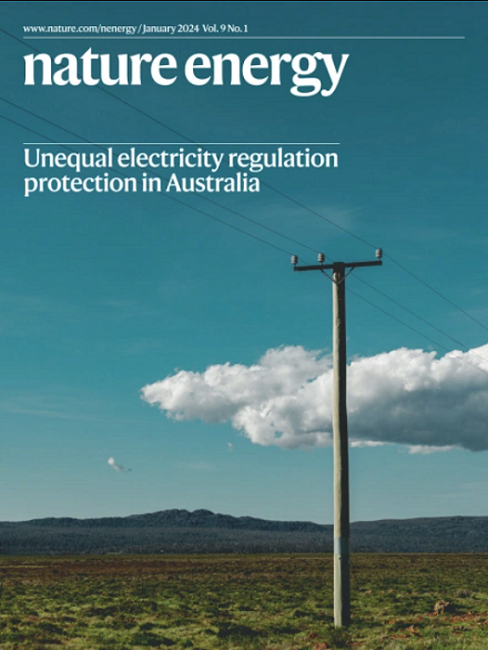纤维素生物炼制厂碳捕集的大规模空间显式分析
IF 49.7
1区 材料科学
Q1 ENERGY & FUELS
引用次数: 0
摘要
纤维素生物燃料的大规模生产将涉及空间分布系统,包括生物质田、物流网络和生物炼油厂。需要更好地理解景观相关决策与供应链背景下带有碳捕集与封存(CCS)功能的生物精炼厂设计之间的相互作用,以实现高效系统。在此,我们利用现实的空间明确土地可用性和作物生产力数据,分析了美国中西部纤维素生物燃料供应链的成本和温室气体减排潜力,并考虑了针对相关二氧化碳流进行详细 CCS 设计的燃料转化技术。优化方法可确定权衡和设计策略,从而建立具有吸引力的环境和经济绩效系统。战略和运营决策取决于基本空间特征,并对生物燃料需求和 CCS 激励措施敏感。美国的二氧化碳捕集与封存(CCS)激励措施忽视了对所有供应链排放源的温室气体减排的激励,这就利用了二氧化碳捕集与封存(CCS)、电价和生物质景观之间的空间相互作用。本文章由计算机程序翻译,如有差异,请以英文原文为准。


Large-scale spatially explicit analysis of carbon capture at cellulosic biorefineries
The large-scale production of cellulosic biofuels would involve spatially distributed systems including biomass fields, logistics networks and biorefineries. Better understanding of the interactions between landscape-related decisions and the design of biorefineries with carbon capture and storage (CCS) in a supply chain context is needed to enable efficient systems. Here we analyse the cost and greenhouse gas mitigation potential for cellulosic biofuel supply chains in the US Midwest using realistic spatially explicit land availability and crop productivity data and consider fuel conversion technologies with detailed CCS design for their associated CO2 streams. Optimization methods identify trade-offs and design strategies leading to systems with attractive environmental and economic performance. Strategic and operational decisions depend on underlying spatial features and are sensitive to biofuel demand and CCS incentives. US CCS incentives neglect to motivate greenhouse gas mitigation from all supply chain emission sources, which leverage spatial interactions between CCS, electricity prices and the biomass landscape. The US Midwest is a promising region for the production of cellulosic biofuel, yet a greater understanding of the interactions between landscape-related decisions, biorefinery design and carbon capture integration is still needed. O’Neill et al. use fine-scale spatially explicit modelling to analyse the cost and greenhouse gas mitigation potential for such fuels in this region.
求助全文
通过发布文献求助,成功后即可免费获取论文全文。
去求助
来源期刊

Nature Energy
Energy-Energy Engineering and Power Technology
CiteScore
75.10
自引率
1.10%
发文量
193
期刊介绍:
Nature Energy is a monthly, online-only journal committed to showcasing the most impactful research on energy, covering everything from its generation and distribution to the societal implications of energy technologies and policies.
With a focus on exploring all facets of the ongoing energy discourse, Nature Energy delves into topics such as energy generation, storage, distribution, management, and the societal impacts of energy technologies and policies. Emphasizing studies that push the boundaries of knowledge and contribute to the development of next-generation solutions, the journal serves as a platform for the exchange of ideas among stakeholders at the forefront of the energy sector.
Maintaining the hallmark standards of the Nature brand, Nature Energy boasts a dedicated team of professional editors, a rigorous peer-review process, meticulous copy-editing and production, rapid publication times, and editorial independence.
In addition to original research articles, Nature Energy also publishes a range of content types, including Comments, Perspectives, Reviews, News & Views, Features, and Correspondence, covering a diverse array of disciplines relevant to the field of energy.
 求助内容:
求助内容: 应助结果提醒方式:
应助结果提醒方式:


